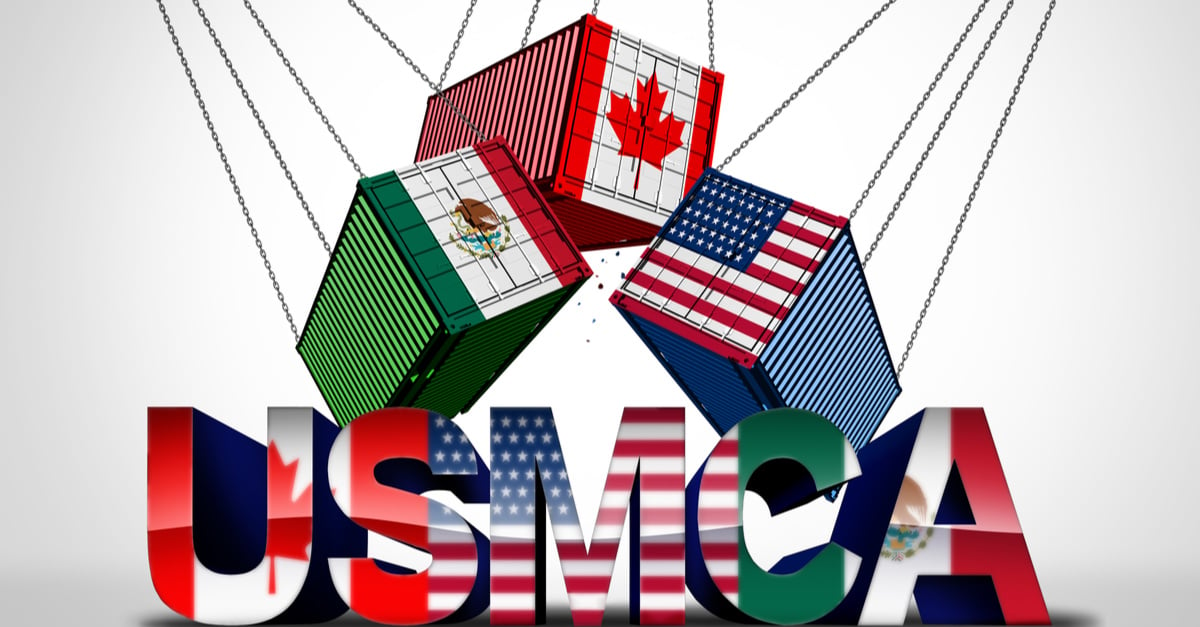
On July 1st, 2020 the new United States-Mexico-Canada Agreement (USMCA) will replace the North American Free Trade Agreement (NAFTA). Here is a USMCA Shipping Documents 101.
What changed from NAFTA to USMCA shipping documents? All the same documents required under NAFTA are still required EXCEPT the NAFTA Certificate of Origin form. Instead of the NAFTA Certificate of Origin form, under USMCA the importer is required to file a Certification of Origin which can be done in any form as long as the 9 required data elements are included.
While the requirement for a Certificate of Origin form has gone away; creating your own Certification of Origin using our template to ensure consistency of the 9 required data elements is a recommended Best Practice. You should also be able to use this template to create a “blanket” form for lanes where you ship the same product regularly.
The nine minimum data elements are:
- Importer, Exporter, or Producer Certification of Origin
- Certifier
- Exporter
- Producer
- Importer
- Description and HS Classification of the Good
- Blanket Period (if applicable)
- Authorized Signature and Date
- Origin Criteria
For your convenience, here is the excerpt of Article 4.2: Originating Goods (Origin Criteria) from USMCA:
Except as otherwise provided in this Chapter, each Party shall provide that a good is originating if it is:
a) wholly obtained or produced entirely in the territory of one or more of the Parties, as defined in Article 4.3 (Wholly Obtained or Produced Goods);
b) produced entirely in the territory of one or more of the Parties using non-originating materials provided the good satisfies all applicable requirements of Annex 4-B (Product-Specific Rules of Origin);
c) produced entirely in the territory of one or more of the Parties exclusively from originating materials; or
d) except for a good provided for in Chapter 61 to 63 of the Harmonized System
i. produced entirely in the territory of one or more of the Parties;
ii. one or more of the non-originating materials provided for as parts under the Harmonized System used in the production of the good cannot satisfy the requirements set out in Annex 4-B (Product-Specific Rules of Origin) because both the good and its materials are classified in the same subheading or the same heading that is not further subdivided into subheadings or, the good was imported into the territory of a Party in an unassembled
or a disassembled form but was classified as an assembled good pursuant to rule 2(a) of the General Rules of Interpretation of the Harmonized System; and
iii. the regional value content of the good, determined in accordance with Article 4.5 (Regional Value Content), is not less than 60 percent if the transaction value method is used, or not less than 50 percent if the net cost method is used.
Additional significant changes you may want to learn about depending on your trade within the region include:
- Intellectual property
- Digital Trade
- De minimis
- Financial Services
- Labor
Intellectual property
The intellectual property chapter of the agreement has been modernized and protections for innovators and creators have been broadened.
Digital Trade
This new chapter provides a foundation for the expansion of trade and investment in innovative products and services.
De Minimus
Under the new agreement Canada has raised it’s De Minimus shipment value from C$20 to C$40 and will provide for duty-free shipments up to C$150. Mexico will continue it’s De Minimus shipment value of USD $50 and also provides duty-free shipments up to the equivalent level of USD $117.
Financial Services
The updated chapter facilitates a level-playing field for financial institutions, investors, and cross-border financial services while preserving the discretion of regulators to ensure financial stability.
Labor
This chapter includes substantial changes including Mexico’s commitment to recognition of the right to collective bargaining and a new labor content rule requiring at least 40% of auto content be made by workers earning at least USD $16 per hour.
To dig further into the nitty-gritty details try these resources:



